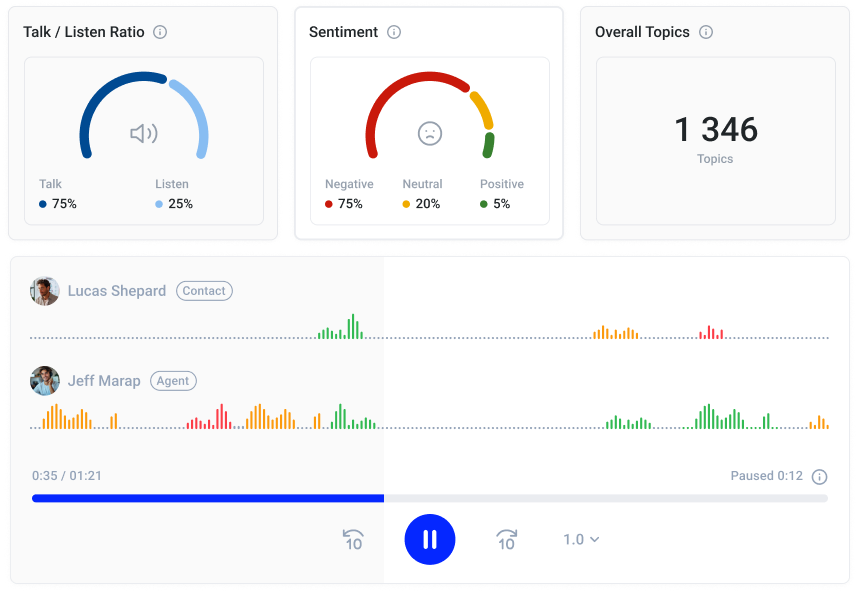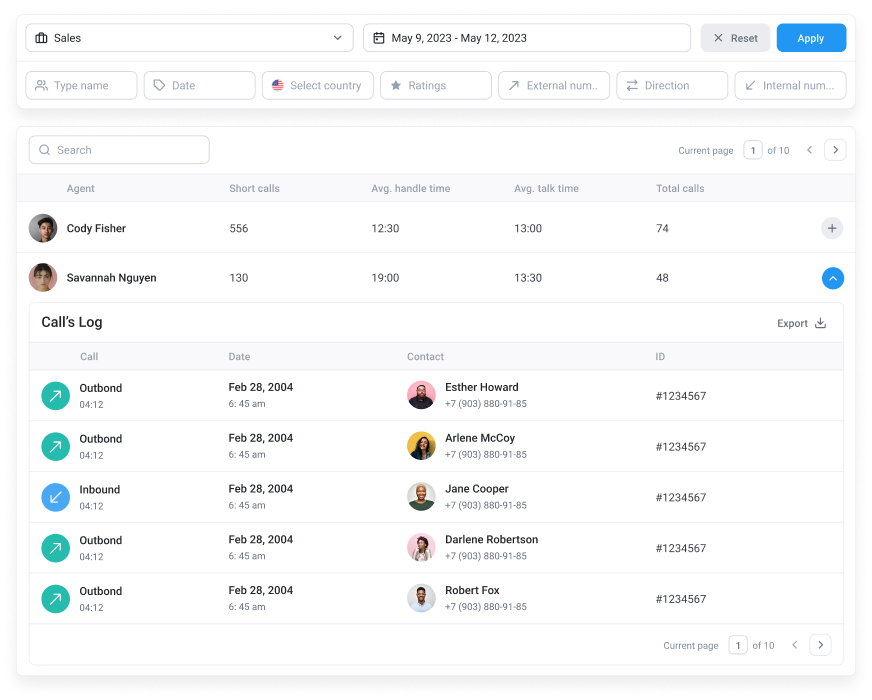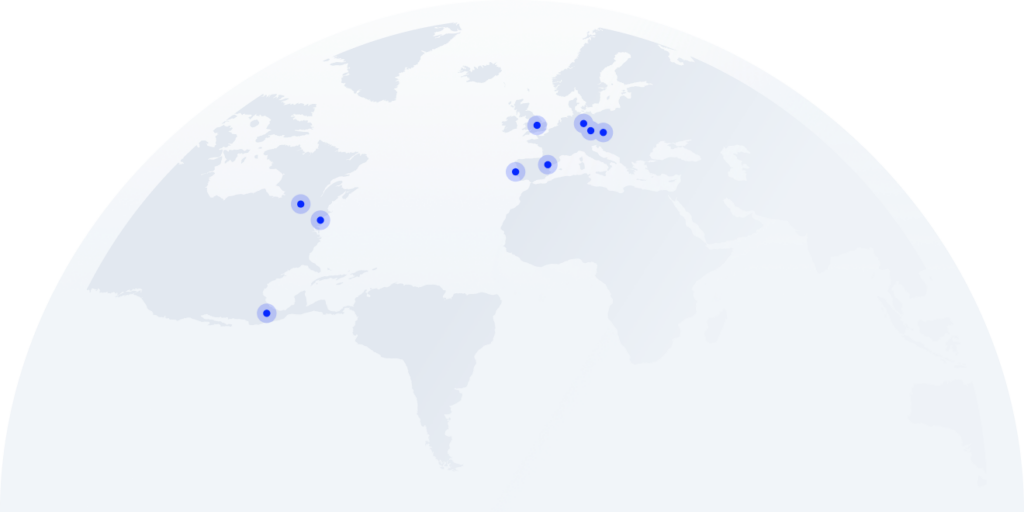If you’re not tracking customer behavior, you’re leaving money on the table. Companies that use customer behavior data to actually understand what people want see 85% more sales growth than their peers.¹
So yeah, you should probably get on that—like yesterday. But if you’re late to the party, don’t panic.
By the end of this article, you’ll be a CBA pro (because honestly, it’s exhausting to write it out every time). You’ll learn how customer behavior analytics works, why it matters, and how to get started.
Key takeaways
-
Customer behavior analytics isn’t optional. It’s how you stop guessing, spot patterns, and make smarter decisions across the customer journey.
-
Data pays off. Using customer behavioral data improves retention, loyalty, and lifetime value while cutting service costs.
-
Tools make it doable. With CloudTalk’s conversation analytics and AI insights, turning clicks into clarity is easier than ever.
Your customer data already holds the answers. Unlock them with CloudTalk.
What is Customer Behavior Analytics?
TL;DR
Customer Behavior Analytics comprises collecting and analyzing data about how customers interact with a business and using those insights to improve experiences, products, and decision-making.
Customer behavior analytics (CBA) is the practice of digging into how your customers act—what they click, when they bounce, how long they hang around, and yes, why they ghost you right before checkout.
The key components of CBA are:
-
Data Collection: Gathering information from sources like websites, apps, CRMs, call centers, and social media.
-
Segmentation: Grouping customers based on behavior, demographics, or value (e.g., frequent buyers vs. one-time customers).
-
Journey Mapping: Tracking how customers move from awareness to purchase and beyond.
-
Predictive Analytics: Using AI and machine learning to forecast future actions like churn risk, upsell potential, or repeat purchases.
Customer Behavior Analytics vs Customer Behavior Analysis
Analysis is the autopsy. Analytics is the heartbeat monitor. One tells you why things went wrong, the other keeps you from flatlining in the first place.
Now let’s dive into why this matters to you.
People are fickle. Customers? Even worse. And who can blame them? There are a million options for everything, from toothpaste to SaaS platforms, so if you don’t understand them better than the next guy, you’ll lose them fast.
That’s where customer behavior analytics comes in—it helps you figure out not just what people are doing, but why, so you can fix problems before they cost you business.
Here’s what that looks like in practice:
-
Catch the breakup before it happens. Predictive analytics customer behavior tools flag when someone’s about to leave, giving you a chance to swoop in with the digital equivalent of flowers and an apology.
-
Make it personal. Digital consumer behavior analysis means you stop blasting the same “Buy now!” message to everyone and start giving people what they actually want.
-
Remove the “ugh” moments. Retail customer behavior analytics shows exactly where shoppers drop off — the confusing checkout page, the clunky app flow, the pop-up from hell. Fix it, and watch the numbers climb.
-
Train your team like pros. Feeding consumer behavior data into conversation analytics software makes agents sharper, faster, and better at actually solving problems. That’s behavior analytics customer service in action.
-
Build long-term value. With ongoing consumer behavioral analytics, you’re not just putting out fires — you’re building a system where customers stay longer, spend more, and (dare we say) actually like you.
Stop customers from ghosting you? Use customer behavior analytics to keep them engaged, loyal, and spending more.
Types of Customer Behavior Data You Can Analyze
If you want to actually analyze customer behavior, you need data. Not creepy, “we’re-watching-you-through-your-webcam” data—just the everyday signals customers give off when they buy, click, complain, or (gasp) compliment. Here are the big four buckets:
1. Transactional Data
This is the who-bought-what-and-when dataset. Think purchase history, order value, frequency, and payment preferences. A customer behavior analysis example here might be noticing that your VIP buyers all upgrade within three months. In retail, shopper behavior analysis of transactional data can reveal which products are repeat favorites versus one-hit wonders.
2. Engagement Data
Every click, open, and scroll tells a story. Engagement data tracks how customers interact with your emails, app, or website. For example: Which blog posts keep people reading? Which landing pages send them running?
This is where shopping behavior analysis comes alive — spotting the difference between casual browsers and high-intent buyers. Tools like conversation analytics software can also show how customers engage on calls and chats.
3. Customer Service Interactions
Every support ticket is a window into your customer’s soul (sometimes an angry one). Tracking calls, chats, and emails gives you customer behavioral data you can use to fix pain points fast. This is where behavior analytics customer service shines: by combining support history with call center analysis, you can predict what customers need before they even reach out.
4. Feedback & Sentiment Data
Numbers are nice, but sometimes you just need to hear how people feel. Feedback data includes surveys, reviews, and NPS scores. Pair that with sentiment analysis from conversations or social media, and you’ve got a live feed of customer emotions.
Sentiment analysis is the process of using natural language processing to identify and classify emotions or opinions in text as positive, negative, or neutral.
Using an AI sentiment analysis tool helps turn this feedback into consumer behavior analytics you can actually act on.
Don’t just collect customer behavioral data—put it to work. See how CloudTalk Analytics makes every interaction count.
Examples of Customer Behavior Analytics in action
Key Customer Behavior Analytics Methods
Alright, so you’ve got the data. Now what? You can either stare at a mountain of spreadsheets until your eyes glaze over, or you can actually use consumer behavioral analytics methods that turn raw numbers into smart decisions. Here are the most common ways to do it:
-
Customer Journey Mapping: Follow your customers step by step—from first click to checkout (or rage-quit). Mapping helps you spot drop-off points and design a smoother path. Think of it as shopping behavior analysis in motion.
-
Segmentation & Cohort Analysis: Not all customers behave the same (shocking, I know). By grouping users by traits like location, behavior, or lifecycle stage, you can personalize messaging and track trends over time. Want to learn more? Check out our guide on the best customer data platforms.
-
Sentiment Analysis: Because numbers only tell half the story. Using tools like CloudTalk’s AI sentiment analysis, you can capture the emotions behind conversations—frustration, joy, indifference — and adjust in real time. That’s where customer behavioural data becomes actionable.
-
Predictive Analytics: The crystal ball of analytics. Predictive customer behavior analytics uses historical data to forecast what customers will do next — whether that’s buying more, canceling, or needing support. CloudTalk’s AI customer behavior prediction is built for exactly this.
-
Voice & Conversation Analytics: Phone calls aren’t dead—they’re just data waiting to be tapped. CloudTalk’s conversation analytics software turns call transcripts into insights you can act on, from sales coaching to compliance tracking.
Predictive Analytics in Customer Behavior
If customer behavior analytics tells you what happened yesterday, predictive analytics is about tomorrow. It uses historical data, machine learning, and a bit of statistical wizardry to forecast things like churn, customer lifetime value, or purchase intent. In other words,it helps you act before the customer ghosts you, not after.
Here’s how businesses actually use it:
-
Forecast churn. Spot early warning signs that a customer is about to leave and step in with retention campaigns. Tools like call center predictive analytics make this possible at scale.
-
Predict customer lifetime value. Use past purchase data to identify your high-value customers and double down on keeping them happy.
-
Anticipate purchase intent. From digital consumer behavior analysis on your website to shopping behavior analysis in-store, predictive models highlight who’s ready to buy (and who’s just window shopping).
-
Personalize in real time. By combining consumer behavioral analytics with AI, you can recommend the right product at the right time — no more random “you might like this” spam.
-
Optimize service delivery. Feeding customer behavioral data into AI customer insights helps support teams anticipate needs, solve problems faster, and boost satisfaction.
Don’t just react to customer churn — predict it, prevent it, and grow smarter with CloudTalk’s AI.
How to Implement Customer Behavior Analytics in 6 Steps
So you’re convinced that customer behavior analytics is the secret sauce. Great. But how do you actually do it without drowning in spreadsheets or crying into your CRM? Easy: follow these six steps.
1. Define Goals & KPIs
Start with the big “why.” Do you want to increase retention, upsell more, or boost customer lifetime value? Be specific. Defining KPIs keeps you from measuring random vanity metrics that look shiny but mean nothing. (Looking at you, page views.)
2. Collect Relevant Customer Data
From purchase history to call transcripts, gather the data that actually reflects how customers behave. This can include shopper behavior analysis in retail, or customer service interactions in call centers. Tools like conversation analytics software make this part easier.
3. Clean and Organize Data
Messy data = bad insights. Organize your customer behavioral data so it’s accurate, complete, and usable. A customer behaviour analysis tools stack might include a CDP, CRM, and call center analysis for visibility across touchpoints.
4. Choose Analytics Methods & Tools
Pick your weapons: predictive customer behavior analytics, sentiment analysis, or segmentation. Platforms like CloudTalk’s conversational analytics turn raw data into actionable insights.
5. Analyze Data & Interpret Results
This is where the magic happens. Use consumer behavior analytics techniques to identify trends, churn risks, and opportunities. For example, a customer behavior analysis example might reveal that repeat buyers churn after two unanswered support tickets. (Shocking, but true.)
6. Apply Insights to Improve CX
Insights are useless if they just sit in a report. Apply them to product updates, personalized campaigns, or better training for your team. Whether it’s digital consumer behavior analysis that improves your website or behavior analytics customer service that makes your agents heroes, the goal is the same: happier customers.
Ready to put customer behavior analytics into action? See how CloudTalk turns data into real results.
Behavior Analytics for Customer Service
Customer service isn’t just about answering phones with a smile anymore. These days, it’s about knowing what the customer wants before they even say “hello.” That’s where behavior analytics customer service comes in—using customer behavioral data to make support smarter, faster, and (dare we say) less painful for everyone involved.
By tapping into consumer behavior data from calls, chats, and emails, support teams can spot patterns, predict needs, and deliver experiences that feel personalized instead of robotic. It’s the difference between “Please hold…” and “We already fixed it for you.”
Here’s how it helps in practice:
-
Personalized responses. Digital consumer behavior analysis helps agents tailor replies to each customer’s history instead of handing out copy-paste scripts.
-
Churn risk alerts. Predictive customer behavior analytics highlights when frustrated customers are about to walk — giving agents a chance to save the relationship.
-
Agent performance monitoring. With call center analytics dashboards, managers can use consumer behavioral analytics to coach agents and improve service quality.
-
Proactive outreach. Using conversation analytics software and AI customer insights, teams can spot issues early and reach out before customers complain.
Recommended Articles
-
AI Sentiment Analysis
Turn Customer Behavior Insights Into Real Business Growth
Systematic customer behavior analysis isn’t optional—it’s the playbook for survival. By analyzing every stage of the journey, you can spot problems early, personalize experiences, and turn “one-and-done” buyers into loyal fans.
The payoff? Better retention. Stronger loyalty. Higher lifetime value. Lower service costs. In other words: more growth, fewer headaches.
And here’s the kicker—you don’t have to do it manually. CloudTalk helps you capture, analyze, and act on customer behavioral data so you can optimize support, improve products, and keep customers coming back.
Ready to make your customer behavior analytics actually work for you? Start turning insights into outcomes with CloudTalk.
Source:
- 01
















